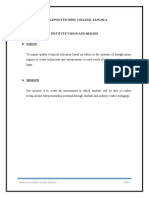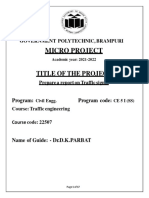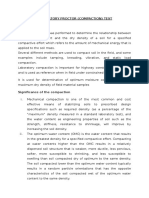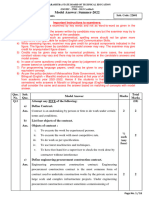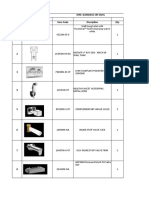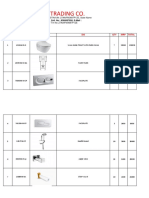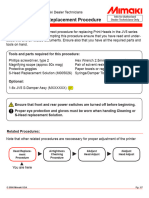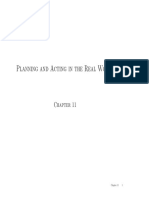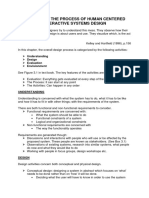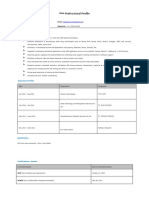0 ratings0% found this document useful (0 votes)
110 viewsSUSHANT Micro Project
SUSHANT Micro Project
Uploaded by
samyak munotThis document provides a classification of tunnels based on purpose, shape, alignment, materials, and supporting arrangements. It describes different types of tunnels including spiral, off-spur, saddle, and slope tunnels classified by alignment. Tunnels are also classified by purpose as conveyance tunnels for water/sewage or traffic tunnels for vehicles. Shape classifications include circular, horseshoe, D-shaped, elliptical, and rectangular tunnels. Tunnels are further categorized based on the type of material as hard rock, soft ground, open cuts, or under river beds. Supporting arrangements such as rock bolts, R.S.J sections, and shotcrete are also discussed.
Copyright:
© All Rights Reserved
Available Formats
Download as PDF, TXT or read online from Scribd
SUSHANT Micro Project
SUSHANT Micro Project
Uploaded by
samyak munot0 ratings0% found this document useful (0 votes)
110 views20 pagesThis document provides a classification of tunnels based on purpose, shape, alignment, materials, and supporting arrangements. It describes different types of tunnels including spiral, off-spur, saddle, and slope tunnels classified by alignment. Tunnels are also classified by purpose as conveyance tunnels for water/sewage or traffic tunnels for vehicles. Shape classifications include circular, horseshoe, D-shaped, elliptical, and rectangular tunnels. Tunnels are further categorized based on the type of material as hard rock, soft ground, open cuts, or under river beds. Supporting arrangements such as rock bolts, R.S.J sections, and shotcrete are also discussed.
Original Title
SUSHANT Micro Project[1]
Copyright
© © All Rights Reserved
Available Formats
PDF, TXT or read online from Scribd
Share this document
Did you find this document useful?
Is this content inappropriate?
This document provides a classification of tunnels based on purpose, shape, alignment, materials, and supporting arrangements. It describes different types of tunnels including spiral, off-spur, saddle, and slope tunnels classified by alignment. Tunnels are also classified by purpose as conveyance tunnels for water/sewage or traffic tunnels for vehicles. Shape classifications include circular, horseshoe, D-shaped, elliptical, and rectangular tunnels. Tunnels are further categorized based on the type of material as hard rock, soft ground, open cuts, or under river beds. Supporting arrangements such as rock bolts, R.S.J sections, and shotcrete are also discussed.
Copyright:
© All Rights Reserved
Available Formats
Download as PDF, TXT or read online from Scribd
Download as pdf or txt
0 ratings0% found this document useful (0 votes)
110 views20 pagesSUSHANT Micro Project
SUSHANT Micro Project
Uploaded by
samyak munotThis document provides a classification of tunnels based on purpose, shape, alignment, materials, and supporting arrangements. It describes different types of tunnels including spiral, off-spur, saddle, and slope tunnels classified by alignment. Tunnels are also classified by purpose as conveyance tunnels for water/sewage or traffic tunnels for vehicles. Shape classifications include circular, horseshoe, D-shaped, elliptical, and rectangular tunnels. Tunnels are further categorized based on the type of material as hard rock, soft ground, open cuts, or under river beds. Supporting arrangements such as rock bolts, R.S.J sections, and shotcrete are also discussed.
Copyright:
© All Rights Reserved
Available Formats
Download as PDF, TXT or read online from Scribd
Download as pdf or txt
You are on page 1of 20
Micro Project
DIPLOMA IN CIVIL ENGINEERING
AFFILIATED TO MSBTE
Shri Chhatrapati Shivaji Maharaj College of
Engineering, Nepti, Ahmednagar
2022-23 Prepared By,
Sushant Jiwade
Classification Of Tunnels
Tunnels Classified On The Basis Of Purpose,
Shape, Alignment, Materials, And Supporting
Arrangements.
1) Classification Of Tunnels According
To Alignment:-
A) Spiral Tunnels:-
Spiral Tunnel Provided To Increase The Length Of The
Tunnel To Avoid Steep Slops In Narrow Valleys.
Tunnels Provided In Narrow Valley In The Form Of Loops
In The Interior Of Mountain So As To Increase Length Of
Tunnel To Avoid Steep Slopes.
B) Off-Spur Tunnels:-
Off Spur Tunnels Are Constructed To Short-Cut Minor Obstacles
Is Very High Projections On The Way, Which Can Not Be
Followed With Permitted Curves.
C) Saddle Tunnels:-
Saddle Tunnels Constructed In Valley Along Natural Slope, This
Tunnels Mainly Used For Transportation Purpose. Or Tunnels
Constructed In The Valley Along The Natural Slope Till Slope
Does Not Exceed Ruling Gradient.
D) Slope Tunnels:-
Tunnel Constructed In Steep Hills For Economic And Safe
Operations Of Roads And Railways Non As Sloping Tunnels, This
Type Of Tunnel Also Used For Transportation Purpose Mainly.
2) Classification Of Tunnel According To Purpose
A) Conveyance Tunnels:-
These Type Of Tunnels Mainly Constructed For Water Supply,
Sewage Lines, And Hydro-Electric Power Supply.
B) Traffic Tunnels:-
Traffic Tunnel Includes Highway Tunnels, Railways Tunnels,
Pedestrian, Navigation Tunnels And Subway Tunnels.
3) Classification Of Tunnels According To Shape
A) Circular Shaped Tunnels:-
This Type Of Tunnels Strong In Order To Resistance To External
Pressure Caused By Water, Soil and Ground.
Circular Shape Tunnels Not Suitable For Railways, And Highway
Transportation Mainly Used For Sewage Lines.
B) Horse Shoe Tunnels:-
Horse Shoe Tunnels Can With Stand Internal And External Pressures,
Having Semi-Circular Rood With arch Sides, Commonly Uses For
Railway And Roadways.
C) D-Shaped Tunnels:-
Where The Risk Of Failure Or Collapse Caused By External Pressure
From Water Or Loose Unstable Soil Conditions On Tunnel Lining Is
Non-Existent, These Types Of Tunnel Roof Also Called Segmented Roof
Takes Up All The Load And Distributes It To The Straight Walls.
D) Elliptical Tunnels:-
The Smaller Cross Section At The Bottom Maintain Flow At The
Required Self Cleaning Velocity, They Used In Grounds Compare To
Rocks And These Tunnels Serve As Water Sewage Conditions.
Elliptical Tunnels Difficult To Construct.
E) Rectangular Tunnels:-
Rectangular Tunnels Suitable For Hard Rock Sites And Mainly Uses For
Pedestrian Passage, But This Type Of Tunnels Are Costly.
F) Egg-Shaped Tunnels:-
Egg Shaped Tunnels Suitable For Sewage Lines As They Have Self
Cleaning Velocity In Dry Weather, Egg Shaped Tunnels Can Resist
External As Well As Internal Pressure.
4) Classification Of Tunnels According To Type Of
Materials
A) Tunnels In Hard Rock:-
Tunneling Through Hard Rock Almost Always Involves Blasting.
B) Tunnels In Soft Ground:-
A Tunnel Built In Soft Ground Such As Clay, Silt, Sand, Gravel, Or
Mud Requires Specialized Techniques Compared To Hard Rock.
C) Tunnels In Open Cuts:-
A Tunnel Constructed By Excavating A Trench From The Surface,
Building The Structure Within The Trench, And Then Backfilling To
Restore The Surface.
D) Tunnels Underneath River Bed:-
Tunnel Constructed Under River Bed Required Special Technique’s.
5) Classification Of Tunnels According To Supporting
Arrangements
•Tunnels Supported By Rock Bolts
•Tunnels Supported By R. S. J Section
•Tunnel Supported By Shotcrete
You might also like
- A Simple Truss Project (Sample)Document14 pagesA Simple Truss Project (Sample)brianna vanderveen100% (2)
- Hành VI Người Tiêu Dùng Nông Thôn Việt Nam MMA - Coc CocDocument29 pagesHành VI Người Tiêu Dùng Nông Thôn Việt Nam MMA - Coc CocNguyễn MyNo ratings yet
- A Micro-Project ON: "Prepare A Report On Channels and Their Geometric Properties"Document13 pagesA Micro-Project ON: "Prepare A Report On Channels and Their Geometric Properties"Fake Account0% (1)
- Types of Connections Used in Steel Structure DSR Ly0unjDocument16 pagesTypes of Connections Used in Steel Structure DSR Ly0unjswapnilrajput1991998No ratings yet
- Aldar Appaso Ashok (Tos Project) (1) New PDFDocument19 pagesAldar Appaso Ashok (Tos Project) (1) New PDFNiket JorwarNo ratings yet
- Micro Project DSRDocument23 pagesMicro Project DSRYash FuseNo ratings yet
- DSR Micro ProjectDocument11 pagesDSR Micro Projectpradnya dhodareNo ratings yet
- PHE Notes 1Document126 pagesPHE Notes 1SY 37 - Purnima PanditNo ratings yet
- BPD Micro ProjectDocument19 pagesBPD Micro Projectgaikwadsonu006No ratings yet
- Mit Polytechnic Pune Micro ProjectDocument9 pagesMit Polytechnic Pune Micro ProjectSatvik TidkeNo ratings yet
- TEN Model AnswerDocument18 pagesTEN Model AnswerCE17 OMKAR BHAPKARNo ratings yet
- Eac Micro Project ReportDocument19 pagesEac Micro Project Report53 Hirole Aadesh100% (1)
- BPD (Report)Document3 pagesBPD (Report)Thorat mayuriNo ratings yet
- Tos MicroprojectDocument10 pagesTos MicroprojectAkash ChourasiaNo ratings yet
- Training ReportDocument57 pagesTraining ReportSonu BhanushaliNo ratings yet
- Railway and Bridge EngineeringDocument14 pagesRailway and Bridge EngineeringMoiz Kutuboddin JinabadeNo ratings yet
- Eac MayuriDocument23 pagesEac Mayuriakshayawari758No ratings yet
- Shivaji Polytechnic College, SangolaDocument22 pagesShivaji Polytechnic College, SangolaShripad KulkarniNo ratings yet
- Hydraulics MicroprojectDocument17 pagesHydraulics MicroprojectAkash ChourasiaNo ratings yet
- Semester: - 4 Name of Faculty: - Ms Chaya Zende. Topic: - Collect Photographs of Different Types of BridgesDocument9 pagesSemester: - 4 Name of Faculty: - Ms Chaya Zende. Topic: - Collect Photographs of Different Types of BridgesVT7VedNo ratings yet
- SQP 22204 Construction MaterialsDocument4 pagesSQP 22204 Construction MaterialsDipak vanjariNo ratings yet
- Micro Project TREDocument18 pagesMicro Project TREMazi ParaNo ratings yet
- Micro Project PHEDocument19 pagesMicro Project PHEABHIJIT BANSODE100% (1)
- RBE Microproject Deep MandokarDocument12 pagesRBE Microproject Deep Mandokar39 - Deep MandokarNo ratings yet
- STP ReportDocument33 pagesSTP Reportn4640974No ratings yet
- BCO Micro Project ReportDocument15 pagesBCO Micro Project ReportSarvesh MoreNo ratings yet
- EST ProjectDocument24 pagesEST ProjectKishor DahihandeNo ratings yet
- Chapter 1: Hydraulic IntroDocument4 pagesChapter 1: Hydraulic IntroSbs Smrt LtaNo ratings yet
- Screenshot 2023-04-17 at 11.09.24 AMDocument15 pagesScreenshot 2023-04-17 at 11.09.24 AMtalhashaikh84485No ratings yet
- WRE Micro ProjectDocument20 pagesWRE Micro ProjectSwapnil MandaleNo ratings yet
- WRE Micro Project ..Document15 pagesWRE Micro Project ..Akash ChourasiaNo ratings yet
- A Micro Project ON: "Prepare A Report On IS Classification of Soil"Document14 pagesA Micro Project ON: "Prepare A Report On IS Classification of Soil"Fake AccountNo ratings yet
- Introduction of Geotechnical Engineering in Civil PracticDocument13 pagesIntroduction of Geotechnical Engineering in Civil Practicqais shaikhNo ratings yet
- 22405-2022-Summer-Model-Answer-Paper (Msbte Study Resources)Document10 pages22405-2022-Summer-Model-Answer-Paper (Msbte Study Resources)Gayatri PatilNo ratings yet
- EAC MicroprojectDocument21 pagesEAC MicroprojectChaitanya Kumbhar100% (1)
- Water Distrributon System: Kais Kotawdekar (3607) INAM HODEKAR (3602) ABRAR KHAN (3614)Document14 pagesWater Distrributon System: Kais Kotawdekar (3607) INAM HODEKAR (3602) ABRAR KHAN (3614)Abrar KhanNo ratings yet
- Micro Project: Title of The ProjectDocument23 pagesMicro Project: Title of The Project725 Radhika RajdharNo ratings yet
- Eac 11 Micro ProjectDocument19 pagesEac 11 Micro ProjectmynameisshubhamkambaleNo ratings yet
- Phe (22504) PrajyotDocument14 pagesPhe (22504) Prajyotadityaudhan65No ratings yet
- Micro Project Report: Roll No Name of Student ProgrammeDocument7 pagesMicro Project Report: Roll No Name of Student ProgrammeSidNo ratings yet
- PHE MICROPROJECT GROUP NO.12 - FinalDocument15 pagesPHE MICROPROJECT GROUP NO.12 - FinalFurious GamingNo ratings yet
- Group 1 Final ReportDocument40 pagesGroup 1 Final ReportmohsinNo ratings yet
- Ten 22507Document16 pagesTen 22507gp031401No ratings yet
- Hen Micro ProjectDocument21 pagesHen Micro Projectpankajrkoli1234No ratings yet
- LABORATORY COMPACTION TEST ImmaDocument9 pagesLABORATORY COMPACTION TEST ImmaIsmail A IsmailNo ratings yet
- HRY Micro ProjectDocument19 pagesHRY Micro Projectgaikwadsonu006No ratings yet
- Emerging Trends in Civil EngineeringDocument3 pagesEmerging Trends in Civil EngineeringInternational Journal of Innovative Science and Research TechnologyNo ratings yet
- Evolution of Highway Failures and Their Maintenance: I R J E T (Irjet)Document11 pagesEvolution of Highway Failures and Their Maintenance: I R J E T (Irjet)Faraz hasan KhanNo ratings yet
- PHE Micro-Project Roll No 43 Om Shinde 1Document16 pagesPHE Micro-Project Roll No 43 Om Shinde 1CE30 Sanket BadadeNo ratings yet
- Civil Engineering TechnologyDocument26 pagesCivil Engineering TechnologyKiptoo BiiNo ratings yet
- Government Polytechnic, Ratnagiri: A Project OnDocument10 pagesGovernment Polytechnic, Ratnagiri: A Project OnPrashant ghadi100% (1)
- 22601-2022-Summer-Model-Answer-Paper (Msbte Study Resources)Document18 pages22601-2022-Summer-Model-Answer-Paper (Msbte Study Resources)Armaan ShaikhNo ratings yet
- Eac Summer 2023Document16 pagesEac Summer 2023footmize.inNo ratings yet
- ETC MPDocument16 pagesETC MPSAURAB SAWANTNo ratings yet
- Bsu Micro Project PavanDocument14 pagesBsu Micro Project PavanVishal JadhavNo ratings yet
- ASU PROJECT GroupDocument13 pagesASU PROJECT GroupPrajkta AhirraoNo ratings yet
- 2017 Summer Model Answer Paper PDFDocument19 pages2017 Summer Model Answer Paper PDFŠhekhař ĎighĕNo ratings yet
- Capstone ProjectDocument41 pagesCapstone ProjectCLASH GAMINGNo ratings yet
- Isa Sunasara & Jigar Barot ("Identification of RCC Element There Mantanance and Repair")Document74 pagesIsa Sunasara & Jigar Barot ("Identification of RCC Element There Mantanance and Repair")Isa SunasaraNo ratings yet
- Jaya Patil2815Document8 pagesJaya Patil2815jayeshbaviskar9501No ratings yet
- Building Landmarks - Bridges, Tunnels and Buildings - Architecture and Design | Children's Engineering BooksFrom EverandBuilding Landmarks - Bridges, Tunnels and Buildings - Architecture and Design | Children's Engineering BooksNo ratings yet
- Shri. Gangwal Sir-Sahil SR No. Product Image Item Code Discription QtyDocument6 pagesShri. Gangwal Sir-Sahil SR No. Product Image Item Code Discription Qtysamyak munotNo ratings yet
- Shri. Manoj Kasliwal-Safal SR No. Product Image Item Code Discription QtyDocument6 pagesShri. Manoj Kasliwal-Safal SR No. Product Image Item Code Discription Qtysamyak munotNo ratings yet
- Shri. Gangwal Sir-Tanvi SR No. Product Image Item Code Discription QtyDocument6 pagesShri. Gangwal Sir-Tanvi SR No. Product Image Item Code Discription Qtysamyak munotNo ratings yet
- Shri. Gangwal Sir-Common SR No. Product Image Item Code Discription QtyDocument6 pagesShri. Gangwal Sir-Common SR No. Product Image Item Code Discription Qtysamyak munotNo ratings yet
- Emma HarkerDocument1 pageEmma Harkersamyak munotNo ratings yet
- Siddhi ConstructionDocument16 pagesSiddhi Constructionsamyak munotNo ratings yet
- 4 Hours / 70 Marks: Seat NoDocument4 pages4 Hours / 70 Marks: Seat Nosamyak munotNo ratings yet
- Mboxcox, Interpreting Difficult Regressions: 2 AnswersDocument1 pageMboxcox, Interpreting Difficult Regressions: 2 AnswersvaskoreNo ratings yet
- Tesla TV 50E635SUS Specifications ENGDocument2 pagesTesla TV 50E635SUS Specifications ENGvedo11No ratings yet
- JV5 Head ManualDocument6 pagesJV5 Head Manualsanmaru77No ratings yet
- Planning and Acting in The Real WorldDocument41 pagesPlanning and Acting in The Real WorldARTARANA BISWA PRASAN DASHNo ratings yet
- SEBI Grade A Exam Pattern 2020Document20 pagesSEBI Grade A Exam Pattern 2020Mehul MayankNo ratings yet
- Introduction To Query Optimization: Advanced Topics GuideDocument27 pagesIntroduction To Query Optimization: Advanced Topics GuideKevon ScreamoNo ratings yet
- R Programming Cse I & IIDocument59 pagesR Programming Cse I & II228a1a0558No ratings yet
- History of Educ - TechDocument5 pagesHistory of Educ - Techjiggly pop100% (1)
- Introductory Statistics With RDocument84 pagesIntroductory Statistics With RTamim IqbalNo ratings yet
- Chapter 3 - The Process of Human Centered Interactive Systems DesignDocument3 pagesChapter 3 - The Process of Human Centered Interactive Systems DesignAntonyNo ratings yet
- Cuda - New Features and Beyond Ampere Programming For Developers PDFDocument78 pagesCuda - New Features and Beyond Ampere Programming For Developers PDFjackopsNo ratings yet
- E.L Iec 61960-3-2017 2019-10-29Document3 pagesE.L Iec 61960-3-2017 2019-10-29Helmer AcevedoNo ratings yet
- Naukri RajaSekharE (12y 0m)Document7 pagesNaukri RajaSekharE (12y 0m)Ram NNo ratings yet
- Types LiquidityDocument10 pagesTypes Liquiditysatori investmentsNo ratings yet
- LWS Wireless PTZ Security Camera User ManualDocument50 pagesLWS Wireless PTZ Security Camera User ManualArt SanchezNo ratings yet
- Bearing WearDocument8 pagesBearing WearcristianomacielbizzottoNo ratings yet
- Get Offshore Electrical Engineering Manual 2nd Edition Geoff Macangus-Gerrard Free All ChaptersDocument62 pagesGet Offshore Electrical Engineering Manual 2nd Edition Geoff Macangus-Gerrard Free All Chaptersauspuhoraz100% (4)
- Academic Research & Writing Skills Part 1 & 2: March 2009Document15 pagesAcademic Research & Writing Skills Part 1 & 2: March 2009Somaia Al FaqehNo ratings yet
- Journal of Power Sources: Xiaowei Zhang, Tomasz WierzbickiDocument10 pagesJournal of Power Sources: Xiaowei Zhang, Tomasz Wierzbickimuhammad mohamadNo ratings yet
- Revolt UM RV400 91219 PDFDocument48 pagesRevolt UM RV400 91219 PDFjohnloganmac100% (1)
- Handout BTech 2022-23 CE 5th Sem DDRCSDocument8 pagesHandout BTech 2022-23 CE 5th Sem DDRCSlandachaitanya07No ratings yet
- Detective's Notebook - SoD Modding All-In-One Reference by HatBeemoDocument12 pagesDetective's Notebook - SoD Modding All-In-One Reference by HatBeemoseqseq13No ratings yet
- Advantages and Disadvantages of Mixed Methods ResearchDocument2 pagesAdvantages and Disadvantages of Mixed Methods ResearchRojina50% (2)
- Question BankDocument13 pagesQuestion BankPoornima VasanthNo ratings yet
- Nasscom List 2xls PDF FreeDocument707 pagesNasscom List 2xls PDF FreebhanuprakashonsNo ratings yet
- Predicted Overbite and Overjet Changes With The Invisalign Appliance: A Validation StudyDocument7 pagesPredicted Overbite and Overjet Changes With The Invisalign Appliance: A Validation StudySandy Paulina de JimenezNo ratings yet
- Cyber Terrorism and Indian LawDocument26 pagesCyber Terrorism and Indian LawAbhishekGargNo ratings yet
- Item 1 FAQ On Epoxy CoatedDocument15 pagesItem 1 FAQ On Epoxy CoatedIvan Trullàs TuguesNo ratings yet
- Hilti Direct Fastening SystemDocument24 pagesHilti Direct Fastening SystemkhuNo ratings yet

















